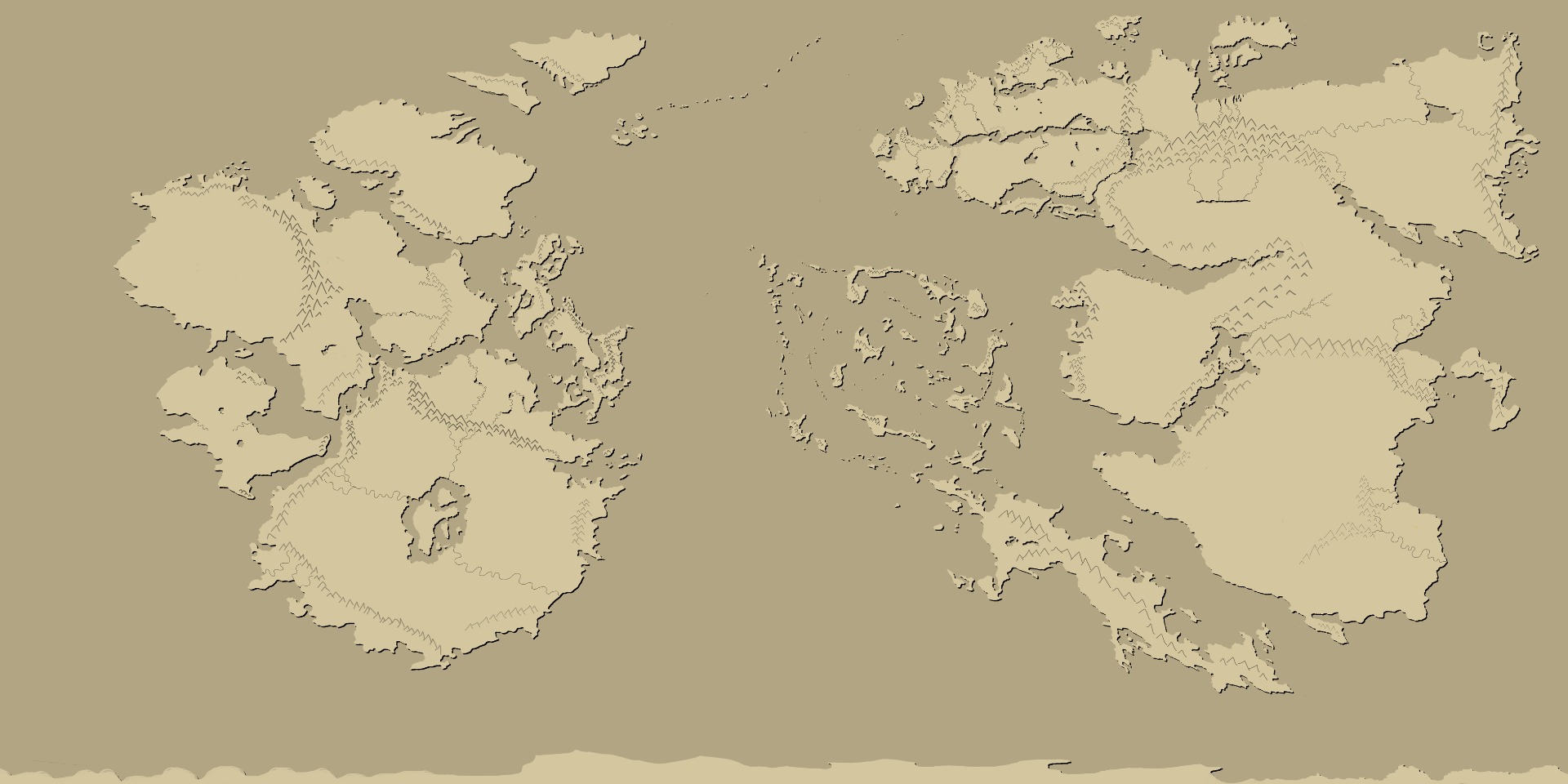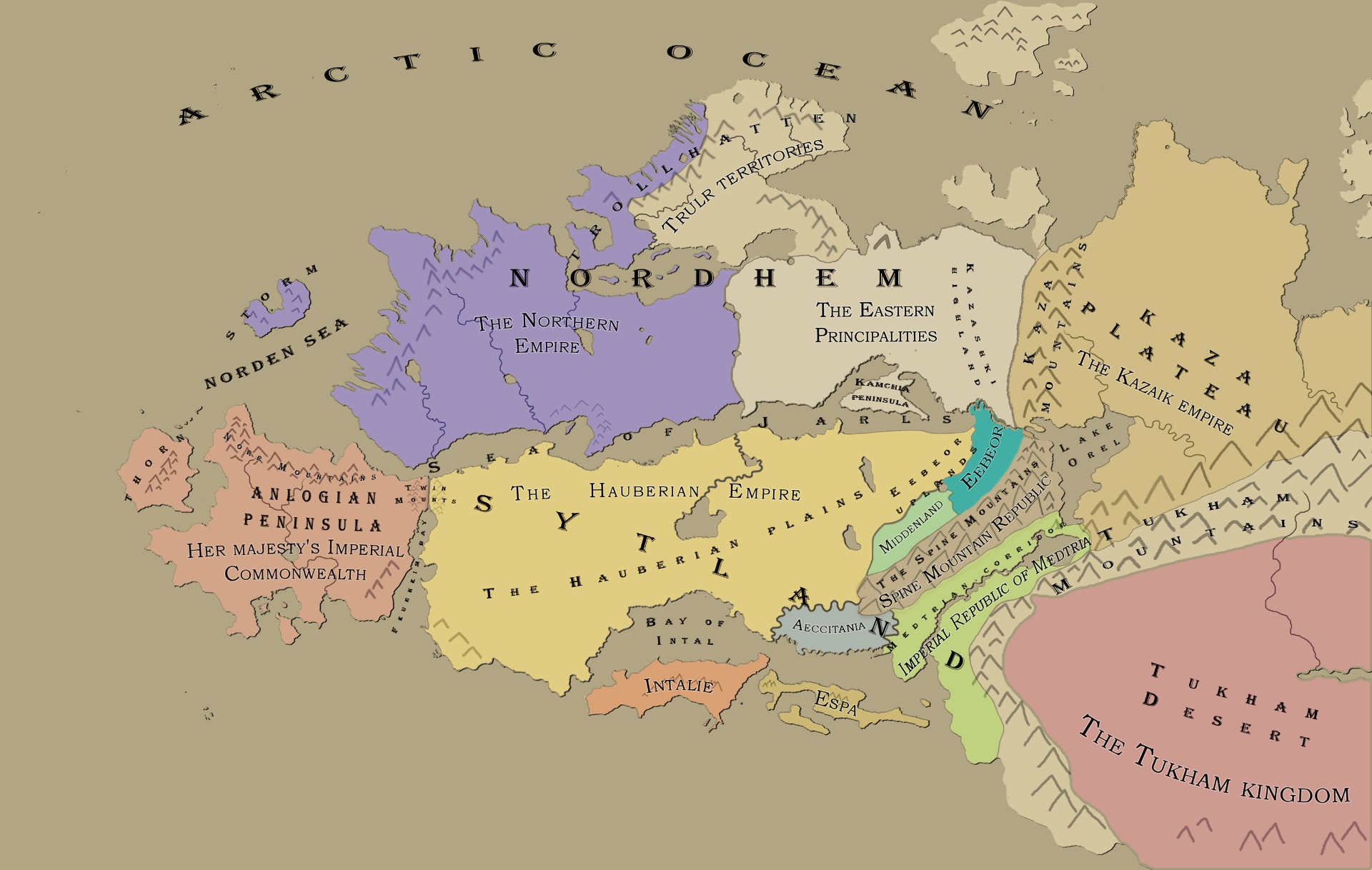
Stora, the old world
Stora, the old world
Commonly referred to as the old world is the largest connected landmass in the world. Geographically it stretches far in latitude, and some in longitude. The continent holds many different biotopes separated by natural borders, and is the home of the majority of the world's major civilizations. The old world is divided into several continental areas, these being Evperia, Retroa, Orien, Lilla, and Baragast.
Evperia
Long considered as the cradle of society, Evperia occupies the whole of the north western lands of the old world. It neighbors Retora and the Retroa steppes to the northeast, and Orien and the Tukham desert to the southeast.

Evperia, on average, has a mild climate with seasonal changes. Along the southern coast, wet climate dominates with hot summers and mild winters. Going north the temperatures get milder, with warm summers and cold winters, where the landscape fills with fields and forests until encountering the sea of Jarls which divides the Evperian continent. Further north, the seasonal changes become more apparent with warm summers and cold winters along the coat of the sea of Jarls, while the inland have mild summers and very cold winters. Reaching the most northern parts, summers are short with moderate temperatures along the coasts and cold interiors, while winters are long, dark, and very or extremely cold. Within these climate areas are smaller ones that break from the average, specifically mountainous areas where height and rain shadow affect the local variation.
There is also a variation of dryness between parts of the continent. The western part has a large coastal area affected by warm water currents which produce a lot of moisture that prevailing winds push in over the land. The east in contrast is largely dry inland with most of the moisture from the winds getting trapped on the slopes of the large mountain ranges.
The continent is divided into several geographical regions. The major of these are The Anlogian peninsula, Sytland, Nordhem, and the Kaza plateau.
The most westerly major region is the Anlogian Peninsula. The peninsulas landscape goes from lowland, especially along the southern coast, to upland in the middle of the land, to a mountainous area in the north. The mountain range is officially named the Norr Mountains but locally called the Norrs. Along the western coast, and with parts on both the northern and southern coast, there are temperate rainforests growing while in the inland and towards the east there are large plains and hardwood forests. In the east of the peninsula lies a land bridge where two mountain ranges, the Twin mounts, that together with the large Feurheim bay separate the Anlogian peninsula from the region of Sytland, where the grand Hauberian plains that streches from the eastern Twin until it reaches the Spine mountain range in the south and the Eebeor uplands in the west.
The Hauberian plains have on average a dryer climate as the cold water in the Feurheim produce less precipitation but because of the Spine mountains, the western part of the plains receive more precipitation as the moisture carried by the westerly winds is released in the slopes of the mountains. As an effect there is numerous rivers and streams flowing down and creates long rivers throughout the whole area. Thanks to these waterways the plains are lush with green, and closer to the mountains large hardwood forests grow.
The Eebeor uplands is in the north-western part of Sytland, covering the area between the Spine mountains and the sea of Jarls, which is a large body of water that separates both Sytland and the Anlog Peninsula form Nordhem in the north. The uplands is mostly an open landscape of hills with outcroppings, with occasional patches of brush and small forested areas.
Almost in the middle of the Sytland region, the Spine mountain range goes from near the coast in the south, westward until it reaches the northern shores of Lake Orel. The mountain range gets its name from the many jagged and pointy mountains it has, many of which rise high enough to keep a year round snow cover. The steep slopes create a variety of valleys with vegetation being vastly different depending on which side it is. The west side being windward has green mountain grasslands and shrub land while the eastside being leeward is very dry with desert areas and rough brush lands. Both sides share areas of tundra in the highest regions. In the western part of the mountain is a large valley that is mostly cold desert as it is caught in the rain shadow, as it is surrounded by high mountains on all but the north-eastern side.
In the south part of Sytland, running between the Spine mountains and the Tukham mountains lies the Medtrian corridor lies. This naturally formed corridor funnels warm and seasonally moist winds north-east towards the Kaza plateau. In the middle of the corridor an ocean inlet called the Medtrian arm runs, leading to a bay far inland, this being the Medtrian bay. The climate is dry with hot summers and cool winters up to the Medrian bay, where of the inner lower corner where a small arm of the Tukham mountains reach north and creates a hook that narrows the path and gathers clouds which shower the landscape, giving the area a humid climate and green landscapes. Beyond the bay is a stretch of land going to the shores of Lake Orel, commonly called the Kaza passage as it lies in the narrowed area of the small arm of the Tukham mountains and the Spine mountains. The area has large forests as it receives heavy precipitation year round because of it being caught between two large bodies of water. The area has strong seasonal changes with hot humid summers as winds from the west pulls in warm air during summers and freezing wet winters as cold winds from the Kaza plateau rushes down during winter.
The Kaza plateau is the largest region of Evperia, taking up all of the eastern part of the continent. Starting at the shores of Lake Orel in the south-west, the region stretches north along the Kaza mountains and west along the Tukham mountains all the way to the northern coast. The western part is a lower area of plainlands with sparse areas of mixed forests of hardwoods and evergreens. This is also true for most of the northern part of the area as well exept for the most northern part being taiga. The eastern part is a large plateau that follows the Tukham mountain range to its south and east. On the outer edge there is steppe land that going in towards the mountains along with a higher altitude transition into a desert. Though the region is dry, there are some amounts of precipitation depending on the season. In the west during summer, moist air from Lake Orel moves over the lower plains along the Kaza mountains towards the northern coast. During winter the prevailing winds change and cold air flows down from the arctic ocean off the north coast. As for the steppe lands, occasionally there will be some rain during summer while during winter snow is common. Still very little precipitation ever manages to reach the upper and inner part of the plateau, leaving it a cold desert.
West of the Kaza plateau, on the other side of the Kaza mountains is the region of Nordhem. The easter part starts on the slopes of the Kaza mountains, turning into the Kazashki highland which covers the south-eastern corner of the region. Going westward from the highlands along the coast one finds the Kamchia peninsula that spreads out into the Sea of Jarls. The peninsula is largely lowland with the edges being tidal wetlands that get flooded regularly by the waters of the Sea of Jarls. After the Kamchia peninsula along the whole south coast, and most of the east coast, the land is flat and largely covered by forest that makes a clear shift some ways inland going north the terrains becomes more hilly and leafy hardwood forests become boreal forests that continue to the Troll
sea and the Great lake. Beyond these to the north is Trollhatten, a peninsula dominated by a mountain range and tundra. The north-western part of Nordhem has another mountain range, named the Norns as there are three pronounced peaks in different shot belts next to one another. The south side of the mountains connects with the hilly forests of the inland while the north side hosts massive fjords.
With prevailing winds changing with the season, Nordhem have some variety of climate. The Kazashki highland and the Kamchia peninsula have warm summers, where the peninsula have a moderate amount of precipitation but the highlands experience a lot as clouds coming from the Sea of Jarls release their moisture on the slopes of the Kaza mountains. In contrast winters in the highlands are bitter cold and very dry as the area experience the rain shadow of the mountains with the wind now being easterly. The peninsula, being surrounded by water, has a more moderate cold and some minor precipitation during winter. The south coast of Nordhem also have warm and very wet summers as warm currents produce higher amounts of precipitation. Thanks to this a temperate rainforest grows all along the coast. Winters become moderately cold and wet because of the same currents. The inland see warm summers and very cold winters while precipitation changes little as during summer winds bring moisture from the Sea of Jarls and during winter moisture comes from the Arctic Ocean. Trollhatten have short and moderately warm summers with some precipitation on average. Winters are long and bitterly cold as the area receives harsh winds from the polar region. Winters also see heavy snowfall as moisture from the arctic ocean sweep in with the winds.
Off the coast of Evperia are several large islands, these being; Thorn, Storm, Intalie, and Espa.
Thorn lie of the west coast of the Anlogian Peninsula separated by the Thorn sound, with two narrow straits, one northern and one southern, called the spikes. Thorn island has a hilly terrain with many outcroppings. It is covered to a large extent of temperate rainforest near the coasts, and fields more common towards the center of the island.
The island of Storm lies in the north-west of Evperia, with the Anlogian Pensinsula to its south and Nordhem to its east. The island consists of two mountains with a stretch of land between them and the shape of the island forms a natural bay between the mountains on the north side. The island has a lot of temperate rainforest and heavy vegetation as it receives heavy precipitation year round as it is surrounded by warm water currents going north.
Intalie and Espa both lie of the coast of Sytland. Intalie is the larger of the two situated to the east. The island stretches along the Sytland coast and is separated from the mainland by the bay of Intal. The terrain is largely hilly and rocky, with plains and gullys covering the majority of the island. The exceptions are the northern tip, where high precipitation give more vegetation, and in the south that spots a volcanic mountain that become active at times. Summers are hot and winters are warm, but it is dry year round. Espa lies west of Intalie and while being much smaller, it shares the same hilly and rocky terrain but have no deviating feature like Intalie. The climate is also like that of Intalie.
Because of its many mild areas in the western and southern parts, Evperia is very suitable for agriculture. There are also many naturally occurring species of edible plants and animals to hunt, a good amount of which have been domesticated. Leading scholars say that this made it possible for previously nomadic people to settle and become agrarian societies, the first of which are said to have been established in the Medtrian corridor, and then spreading throughout the rest of the continent. While being widely accepted this theory is not without critics, some claiming that knowledge of agriculture in the middle and north of Evperia would have been contemporary and even predate that of the south. Whatever the case may be, the reality is that Evperia is home to many countries and people. Humans are the majority inhabitants, followed by Dworig. There are some enclaves of Uruk in the south and in the far north of both Nordhem and the Kaza plateau there are some Trulur tribes roaming. There has not been any settled Ailvu in Evperia since the end of the era of conflict, but from time to time stories of Ailvu travelers have been told.
Retora
Continental Retora stretches from the Tukham mountains in the west all the way to the sea in the east. It neighbors Evperia to the west and Orien to the south. Retora consists largely of steppe and taiga with smaller areas of tundra in the north and subtropical areas in the south. The taiga stretches all the way across the continent along the northern coast with the exception in the north eastern corner of the continent which is tundra. Going south the taiga turns into a steppe which stretches from the Tukham mountain range in the west all the way to the eastern mountains and down to the southern coast where areas of more humid subtropical climate can be found, especially along the south coastline.
Retora is on average a wet continent with moderate precipitation year round with the exception of the inland steppe which suffers from a year round high pressure influence of central Orien which pushes warm and dry air eastwards making rain scarce. The south eastern corner of the continent sees high seasonal precipitation with wet summers but dry winters. But parts of the southern coast on the other hand see year round high precipitation. Along the east coast the Eastern mountain chain rise and cuts the large plains of from the coast. The northern part of the mountains is wet and humid as it captures the moist winds coming in from the ocean, which also moderates the overall climate of the area. In the southern part it is the reverse as the winds travel out to sea and leaves a mostly dry climate with only seasonal rainfall, with the exception of the most southern area which have year round precipitation.
Orien
Orien is the central area of the northern part of the old world, connecting Evperia and Retora to the southern Stora. Orien is mainly defined by its two major climates areas, these being the Tukham desert and the Gupta jungles. The Tuhamn desert is a vast dry area with the Tukham mountains all along the western and northern edge, which captures all moisture coming with the trade wind. The desert connects with the Orien bay in the south but the cold waters combined with year round off-shore winds leaves a very dry landscape. The desert stretches nearly all the way from the base of the Tukham mountains in the west to the bay of Retora in the east. The majority of the areas see little to no precipitation all year except for areas near the base of the Tukham mountains that have a seasonal wet period with light amounts of precipitation. Thanks to this and glacial melt from the massive mountains in the greater Tukham mountains in the north there are three rivers that flow into the central area of the desert and end in the endorheic body of saline water called the Gwitumen sea. Towards the east the desert slowly transforms into savanna and then into tropical forest of Gupta in the south where precipitation is present year round, with very wet summers. The southernmost part of Orien borders to Baragast via the Eshas mountain range.
Lilla
Lilla is the western part of southern Stora. Most of Lilla borders to water, to the north there is the Orien sea, to the west is the archipelagic sea, to the south is the grand bay of Lilla, and to the south west is the gulf of Buktamali. The north western part of Lilla connects to Orien where the hook mountains acts as a natural border. Lilla see year round precipitation with some few exceptions where rain is either seasonal or lacking year round. It is hot year round with summers being very wet with heavy seasonal rains. The majority of Lilla is of a tropical savannah climate with areas of tropical jungle along the gulf of Buktamali, and sub-tropical areas in the north along the Orien sea. The coast along the archipelagic sea have areas where the rain shadow of the local mountains make for dry winters and very wet summers. The same goes for minor areas along the south coast. Two areas stand out from the rest with year round dryness as both are caught in perpetual rains shadows. One area is in the in the mountains of the northwestern coast and the other is in the foothills of the northern hook mountains.
